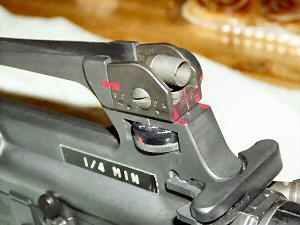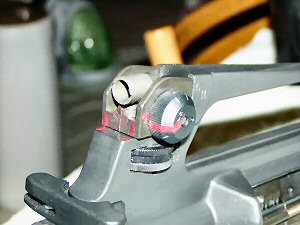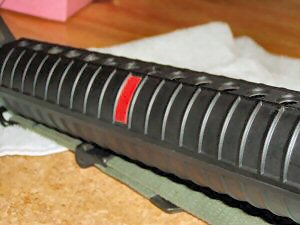
In the winter of 2005 I switched to a White Oak Precision upper receiver with a pinned 1/4x1/4 rear sight. It has two stainless steel pins that constrain all rotation of the assembly giving it the same micrometer level precision as one would find in a match gun sight like a Centra, RPA, Zelenak, et al. It takes precision and repeatability to a whole new level and once again confirms the AR-15 is in a class without peer for use in Service Rifle competition. To be complete M-16/AR-15 sights come in 1 MOA, 1/2 MOA, 1/4 MOA and even 1/8th MOA configurations.
On to marking the sights. The school book solution is to start with placing a mark on the elevation drum indicates the base setting for the rifle roughy 6 MOA up from bottoming the rear sight. The 6 MOA of cushion is important so you can dial down for 100-yd matches and use other ammunition that has different drop characteristics. Do not make the mistake of bottoming the rear sight. Also place an accompanying mark on the left side of the sight is used to quickly verify that the drum is not out of position by a full turn, something that can easily happen at 4 clicks per MOA.
With the rear sight in this position, the front sight is adjusted for elevation by test firing to locate the 200-yard zero and dialing the front blade. If you have a match front sight that has a tapered blade you will likely need to rotate the sight so it hits a little low and file down to make the final adjustments.
Cheating trick. I actually set my rear drum and put the reference mark at 4 MOA up from the bottom and dial the front sight in for elevation at 100 yards then work out the number of click to dial up for 200, 300 and 600. That's because as a civilian competitor it's easier for me to find shooting ranges where I can re-check the sights at 100 yards and you don't need a target puller to help you.
IMPORTANT STUFF:
- Do this sight tuning only after you have broken in your barrel and be sure to use the loads you will be using for the short range portion of the highpower course, 200 and 300 yards.
- Do make sure the loads are accurate. All AR-15's are capable of sending rounds from good ammo into a quarter at 100 yards.
- As a rule, 1-12 barrels like 52gr to 55gr bulltets best, 1-9 barrels seem happiest with 62gr to 77gr, and the highpower competition 1-7 and 1-8 twist barrels enjoy 69 gr to 77gr loads as far as magazine length ammunition is concerned.
- 80gr loads do not fit in magazines and are strictly 600 yard slow fire stage ammunition. If you use 80's, work on them for your reference sheet separately.
- In case you are wondering I am presently using remanufactured Black Hills 75gr Moly's for reduced and across-the-course matches plus 80gr Sierra Matchking Moly handloads for LR matches.

You then fire the rifle in a no wind condition to locate the windage zero position for your sight. Once found paint a horizontal mark across the windage drum as shown. This is the home base setting of the sight you will use for competition. Always go back to this windage zero for each stage and dial in your wind compensation from there. Chase the wind with a mouse gun at 600-yards for a half-an-hour on a windy day and you'll believe in home basing the sights every stage soon enough.
Once the rear is set up to mechanical center it becomes easy to put on the initial dope, in the case of the rifle in the photo 1 click left of the mechanical zero of the sight, to set up the rifle for the first sighting shot.
If you are fortunate enough to have one of the AR-15 front sight towers with the adjustable hex screws you can further target the rifle so that mechanical center of the rear sight is also windage zero. My competition rifles now have this feature and they are both a blessing and a curse. The procedure is one of patience and tiny movements because the height of the AR-15 sight tower amplifies a hair width of rotation to about a bullseye wide shift. Due the the nature of the language that may result it may be best to make sure no small children are within earshot while you are perfroming this procedure. I highly recommend a tool called an M-16 sight alignment gauge. It's a rod that goes into the carry handle an allows you to optically see the movements in the front tower as you make them with great precision. Then I can visually confirm exactly how stupid that last 1/8th of a turn of the allen wrench really was.

You have your work cut out for you in a highpower rifle match. It is critical that you manage sling tension to be exactly the same from shot-to-shot. This is a chore not to be taken lightly as to it's true degree of difficulty. Perfecting exact sling tension for 22 rounds in 22 minutes of slow fire will raise our metal and physical conditioning to new heights. Consistency in placement of the hands on the forearm is important. It is after all 50% of the biomechanical connection between you and the gun. The red mark shown provides a reference check. You may actually place your hand slightly ahead of the mark for one position and slightly behind it for another for sitting versus prone. Having the mark in place reminds you of the impotance of going to the right place every time.
The other thing you need to do is memorize the position of every fingertip on the gun almost like playing a chord on a guitar or violin. No kidding. Treating the foreend of an AR-15 like it's a Fender makes a big difference in making up for the deficiencies of an un-floated barrel. I've tried this experiment with the old thin tube Viernam-era barrel. Air guitar is a good thing. Other rifles that share this musical instrument precision quality to a lesser extent are service-grade M-1 Garands and the M-14/M1A's. In the case of the Garand, it has a lot in common with a violin that spits but that's what makes as-issued CMP matches so much fun.
If your barel is free floated,
Welcome to another reason why the AR-15 kicks every other rifle's tail in competition. The float tube makes this rifle amazingly forgiving about lapses in sling tension precision. Reasonably consistent now makes the gun very happy. What this really does is allow you to reallocate your mental energy to other aspects of making the shot like sight picture repetition and keeping ahead of the wind. It makes a big difference in your energy budgeting during a match.